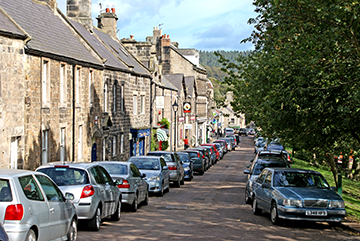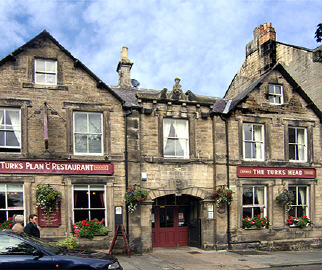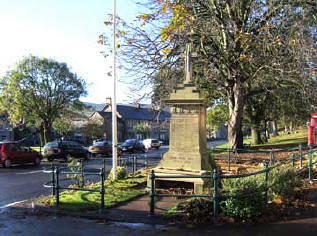High Street
For centuries the High Street has
been the main shopping area of the village and has little changed over the
years; apart from an influx of cars. A few shops at the west end, with the
majority towards the east. Many businesses are family owned and have been
trading on the same premises for decades.

To the east is a house named "West End". This is a building of great historic significance in that it is reputed to be the oldest house in Rothbury. Some years ago the interior was renovated, disclosing enormous curved wooden beams of black oak and a beautiful inglenook fireplace that had lain hidden for many years. Local lore claims that it was once the local lock up and iron bars in the attic appear to substantiate this story.
Splendid buildings of the mid 19th century stand amidst much older properties and do not look at all out of place. Most of the trees were planted in the late 19th Century, have grown to maturity and are now the preferred nesting place for the crows that leave their messages in the spring. A perennial problem that has baffled the Parish Council for many years.
Ogle House, on the left is still know locally as "The Doctor's". Owned by Dr Barrow, this was a surgery for over 70 years; a medical practice that served not only the village but also the whole of Coquetdale.
Dr Barrow achieved a great deal in his busy life. Born in London, moving to Morpeth and settling in Rothbury, he was a man ahead of his time. For over 60 years he was district medical officer at a time when hygiene and sanitation schemes were just starting. He was physician to Lord Armstrong. He was elected to the first Parish Council in 1895. He was chief bell ringer at All Saints for 50 years and a churchwarden for 25.
In the village he was known simply as "The Doctor", a well loved man, also noted for simple things such as giving a new penny to all the children at Christmas. Dr Barrow died in 1948 and at his funeral service the church bells ran in muffled peal. His headstone in the new cemetery bears the simple inscription:
"Having served his
generation
He fell asleep"
Follow the High Street towards the Village Green noting that this area is a favourite spot to sit in the shade and while away the long summer evenings. Mind the crows though!
On Sundays the Vale
Milk Bar attracts motor cyclists who have been visiting Rothbury since time
immemorial and who are now a feature of the village. Bank managers, and
respectable business men, these are a far cry from the
Hell's Angels of popular fiction.
of the village. Bank managers, and
respectable business men, these are a far cry from the
Hell's Angels of popular fiction.
Look in at the Sun Cafe, or the Turks Head, one of the oldest public houses in Rothbury and the main venue for the afternoon sessions during the Music Festival.
The site of the COOP was where the old Bluebell Inn once stood. Only a few stones at the rear are testimony to the old inn.
Read the inscriptions on the War memorial, refurbished
in 2002 with smart new railings: replaced as often as
they are damaged by the every increasing traffic in Rothbury. The memorial
was unveiled on 21st January 1921 by Lord Armstrong officiating for Major
General Sir Percival Wilkinson who was in command of the division to which the
Rothbury soldiers were attached. Names from the 1939-45 and Korean wars
were added later.
The memorial used to feature a water fountain and the tap remains can just be
seen tucked
behind the flowers planted in an ancient trough.
 Continue east to Front
Street glancing up at the three ornamental heads above the Chemist's Shop.
Continue east to Front
Street glancing up at the three ornamental heads above the Chemist's Shop.
Did you know that these are called "gapers" and were used to indicate that the building was a pharmacy. It is believed that they originated in the Netherlands and often showed a man in a turban with his mouth open ready for a pill or medicine.
Look up at Lloyds Bank and admire its beautiful mansard roof. A Mansard roof, sometimes known as a French roof is a four sided roof with slopes on each side creating additional room space at the top of the building and was first popularised by Francois Mansart (1598 - 1660).
Across the road almost opposite Barclays Bank stands the Jubilee Hall at the corner of Bridge Street